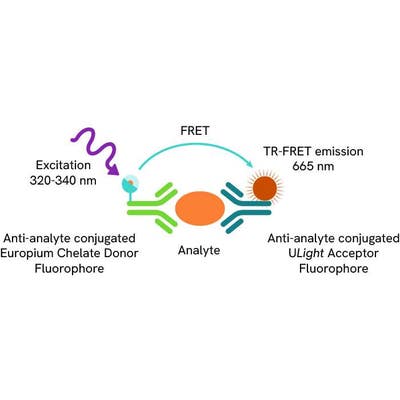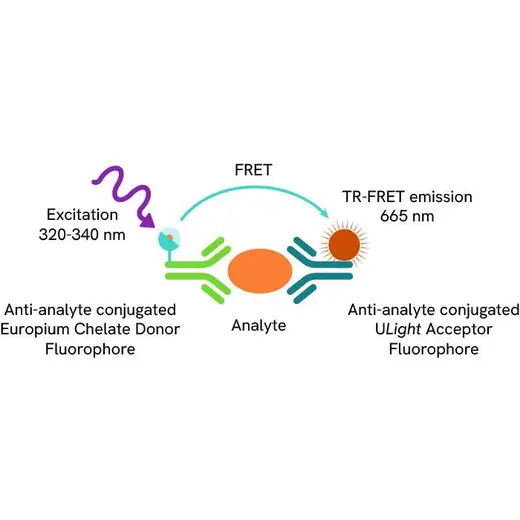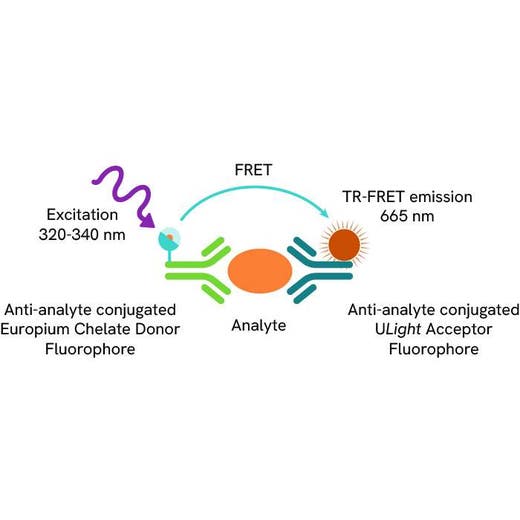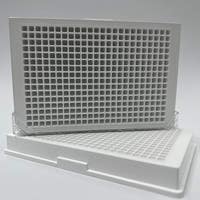
LANCE Ultra Human PDL1 Detection Kit, 10,000 Assay Points

LANCE Ultra Human PDL1 Detection Kit, 10,000 Assay Points




The LANCE® Ultra Human PD-L1 Detection Kit is designed for detection and quantitation of human PD-L1 in buffered solution and cell culture media using a homogeneous TR-FRET (no-wash steps, no separation steps) assay.
For research use only. Not for use in diagnostic procedures. All products to be used in accordance with applicable laws and regulations including without limitation, consumption and disposal requirements under European REACH regulations (EC 1907/2006).
| Feature | Specification |
|---|---|
| Application | Protein Quantification |
| Dynamic Range | 54.6- 100,000 pg/mL |
| Limit of Detection | 54.6 pg/mL |
| Limit of Quantification | 282.9 pg/mL |
| Sample Volume | 15 µL |
The LANCE® Ultra Human PD-L1 Detection Kit is designed for detection and quantitation of human PD-L1 in buffered solution and cell culture media using a homogeneous TR-FRET (no-wash steps, no separation steps) assay.
For research use only. Not for use in diagnostic procedures. All products to be used in accordance with applicable laws and regulations including without limitation, consumption and disposal requirements under European REACH regulations (EC 1907/2006).


LANCE Ultra Human PDL1 Detection Kit, 10,000 Assay Points


LANCE Ultra Human PDL1 Detection Kit, 10,000 Assay Points


Product information
Overview
The LANCE® Ultra Human PD-L1 Detection Kit is designed for detection and quantitation of human PD-L1 in buffered solution and cell culture media using a homogeneous TR-FRET (no-wash steps, no separation steps) assay.
- No-wash steps, no separation steps
- TR-FRET technology
- Sensitive detection
- High reproducibility
- Faster time-to-results
- Easy automation
- 96-well, 384-well, and 1536-well formats
LANCE® and LANCE® (Lanthanide chelate excite) Ultra are our TR-FRET (time-resolved fluorescence resonance energy transfer), homogeneous (no wash) technologies. One antibody of interest is labeled with a donor fluorophore (a LANCE Europium chelate) and the second molecule is labeled with an acceptor fluorophore (ULight™ dye). Upon excitation at 320 or 340 nm, energy can be transferred from the donor Europium chelate to the acceptor fluorophore if sufficiently close for FRET (~10 nm). This results in the emission of light at 665 nm.
Programmed death ligand 1 (PDL-1), also known as cluster of differentiation 274 (CD274) or B7 homolog1 (B7-H1) belongs to the growing B7 family of immune proteins and has been demonstrated to play a role in the regulation of immune responses and peripheral tolerance. Human PDL-1 is constitutively expressed in several organs such as heart, skeletal muscle, placenta and lung, and in lower amounts in thymus, spleen, kidney and liver. PDL-1, together with PDL-2, are two ligands for PD-1 (programmed death 1), a member of the CD28 family of immunoreceptors. By binding to PD-1 on activated T-cells and B-cells, PDL-1 may inhibit ongoing T-cell responses by inducing apoptosis and arresting cellcycle progression. Accordingly, it leads to growth of immunogenic tumor growth by increasing apoptosis of antigen specific T cells and may contribute to immune evasion by cancers. PDL-1 thus is regarded as promising therapeutic target for human autoimmune disease and malignant cancers.
Specifications
| Application |
Protein Quantification
|
|---|---|
| Automation Compatible |
Yes
|
| Brand |
LANCE Ultra
|
| Detection Modality |
LANCE
|
| Dynamic Range |
54.6- 100,000 pg/mL
|
| Limit of Detection |
54.6 pg/mL
|
| Limit of Quantification |
282.9 pg/mL
|
| Product Group |
Kit
|
| Sample Volume |
15 µL
|
| Shipping Conditions |
Shipped in Blue Ice
|
| Target |
PD-L1
|
| Target Class |
Biomarkers
|
| Target Species |
Mouse
|
| Technology |
TR-FRET
|
| Therapeutic Area |
Oncology
|
| Unit Size |
10,000 Assay Points
|
Resources
Are you looking for resources, click on the resource type to explore further.
LANCE™ Ultra TR-FRET is a no-wash proximity assay technology that combines the benefits of time resolution (TR) with fluorescence...
SDS, COAs, Manuals and more
Are you looking for technical documents related to the product? We have categorized them in dedicated sections below. Explore now.
-
LanguageEnglishCountryUnited States
-
LanguageEnglishCountryEU
-
Resource typeManualLanguageEnglishCountry-


How can we help you?
We are here to answer your questions.
































